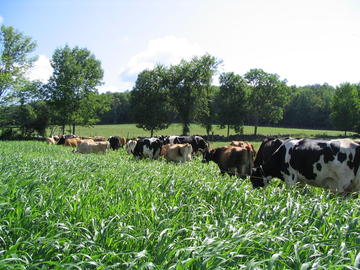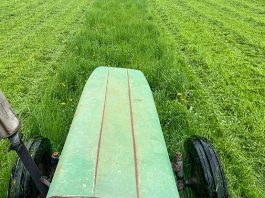
If you’re in one a region suffering from or potentially looking forward to drought, you may alread be looking at potential alternatives for forage production. Here are some ideas for using Forage Sorghum or Milo spring plantings from Karla Hernandez, a South Dakota State University Extension Forages Field Specialist. She writes this for iGrow, a service provide by SDSU Extension.
Forage Sorghum

Forage sorghum can be grown either as grain or forage crop. The advantage of its use over corn is that it requires less water, is drought tolerant by going semi-dormant which makes it a good fit for dryland and limited irrigation situations. Sorghum has less input costs tolerating moderately acid and low fertility soils (yet responding well to fertilization) and it can be harvested multiple times because of its regrowth potential. Forage sorghum also makes excellent hay for supplemental feeding during times of inadequate or low forage production. Perhaps the greatest advantage of sorghum is the diverse management options that the grower can choose from in order to match his production needs.
Growing and Managing Forage Sorghum
1. Forage sorghum should be planted in spring when soil temperatures exceed 60° F at 0.5 to 2.0 inches deep. Seeds may be drilled, broadcasted, or planted in rows spaced 15 to 40 inches apart.
2. Seeding rate is 15 to 25 lb/acre.
3. Should be harvested when the whole plant moisture content is between 63 to 68%.
4. The recommended stage of maturity for harvesting forage sorghum to optimize DM content and nutrient quality is when the grain reaches early to late dough stage.
5. Harvesting earlier during the late vegetative or early head stage of maturity will result in silage with very low DM content (<25% DM), which will result in excess seepage and an undesirable fermentation including higher concentrations of acetic and butyric acid. Wilting is recommended if harvesting is going to occur at this stage. If harvested at the hard dough stage, the forage will have higher DM content, but the grain and stems will be more mature and less digestible. Rolling grain sorghum silage that is in late dough or hard-grain stages of maturity will improve grain digestibility and support improved animal performance.
6. Prussic acid is a problem in young and active growing tissues. The problem can be avoided by not grazing until plants have reached from 18 to 24 inches tall.
7. Sorghum can accumulate toxic nitrate levels under drought conditions. Therefore, grazing during a drought or after a frost stress should be avoided.
Grain Sorghum (Milo)

If you grow corn as a feed source, this is a good alternative. Some of the advantages of producing grain sorghum over corn in dry conditions are:
1. Corn is cross-pollinated. A severe drought at silking time may cause the absence of kernels.
2. Sorghum is self-pollinated and produces heads over a longer time of period. Short periods of drought do not damage pollination and fertilization. In a longer drought, sorghum produces smaller heads but none of them are without kernels.
3. An optimum relationship between plant population and moisture supply is often critical with corn but unimportant with sorghum. When soil moisture is plentiful, sorghum heads grow large and tillers produce heads. But if drought occurs, heads are small and fewer tillers develop. Consequently, sorghum growers can plant high populations for potentially high yields. Corn growers can choose between high populations for maximum yields or lower populations with less chance of serious loss from drought.
4. Sorghum foliage resists drying. At equal moisture stress, corn leaves lose a greater percentage of their water content than do sorghum leaves probably because of the waxy coating on sorghum leaves and stems. This coating often gives the leaf sheaths a sticky, frosty appearance.




Sorghum and Sudan grass are in the same family and can be crossed.
Sorghum × drummondii = sudan grass
Sorghum bicolor = Forage and grain sorghum
+ Sorghum x Sudan (cross of the two)
In our environment (cool/wet) – sorghum requires the most heat, sudan grass the least heat. sorghumxsudan is intermediate. they are all water efficient. I would never attempt to make dry hay (nor balage) with sorghum, sudan grass we can get dry, sorghumxsudan “maybe” we can get dry, it makes excellent balage.
If we have cooler than normal summer temperatures, these species will not have top yields.
sudan grass and sorghumxsudan have excellent regrowth potential. regrowth on sorghum is not strong, typically consider it a single cut plant. I would only consider grazing sudan or sorghumxsudan. I would not graze sorghum.
On good ground, corn still wins in terms of yield, on marginal ground, the sorghum family may be worth considering.
In all of these there are reduced lignin via BMR or WMR traits.
Comments are closed.